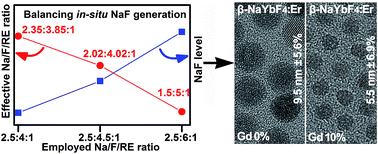Revealing the in situ NaF generation balance for user-friendly controlled synthesis of sub-10 nm monodisperse low-level Gd3+-doped β-NaYbF4:Er†
Abstract
Herein, user-friendly control of the synthesis of sub-10 nm hexagonal (β-) NaYbF4:Er nanocrystals (NCs) with extremely low-level Gd3+ doping (0%, 10 mol%) was achieved. We reveal for the first time that the effective sodium/fluoride levels during the formation of cubic (α-) nuclei are not only controlled by the sodium/fluoride to rare-earth precursor ratios used, but also sensitively restricted by the in situ NaF generation reaction in a sodium oleate-based solvothermal system. Excessive in situ NaF generation will lead to a respective sodium- and fluoride-deficient environment, delayed α-to-β transition and larger β-NCs. Based on these effects, sub-10 nm monodisperse low-level Gd3+-doped β-NaYbF4:Er was obtained with a user-friendly low fluoride dosage by finely balancing this NaF generation reaction and achieving an intrinsic optimized sodium-fluoride level for NC nucleation. Notably, our work represents the first example where the focus is on the competing in situ NaF generation reaction and its use for nucleation regulation, as well as for the user-friendly control of the solvothermal synthesis of sub-10 nm β-NaYbF4:Er.



 Please wait while we load your content...
Please wait while we load your content...